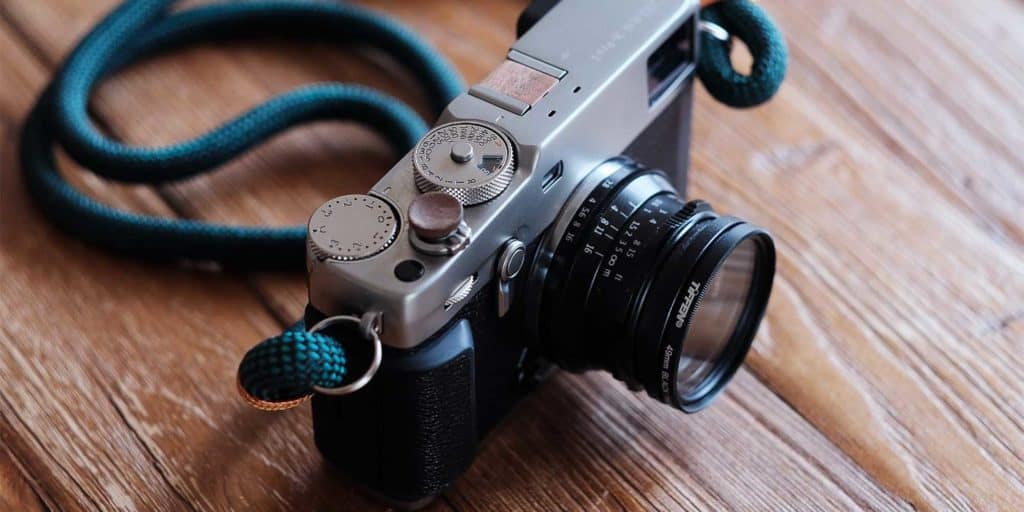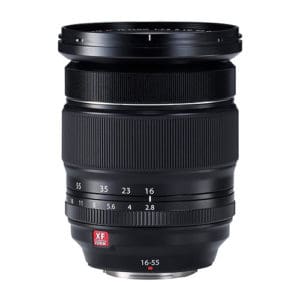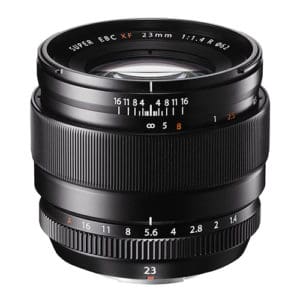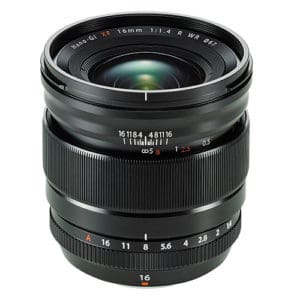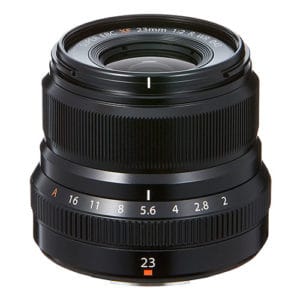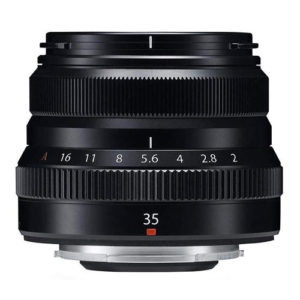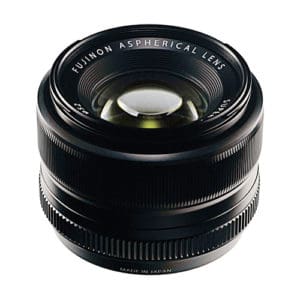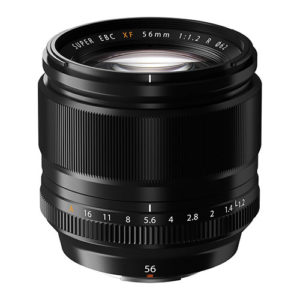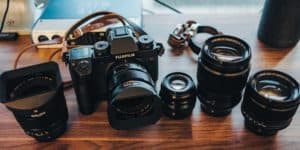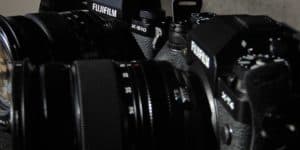Sleek, stylish – perhaps even a little bit exclusive – Fujinon’s X-Pro3 is a highly desirable camera.
But with its retro stylings and idiosyncratic quirks, it’s also one that tends to appeal to a very specific kind of photographer.
Essentially the X-Pro3 is designed to simulate the experience of working with a classic 35mm analog rangefinder – but in the digital realm.
As a result, it’s a camera that largely appeals to photographers shooting travel, documentary, and street photography.
But just as you tend not to see Leica M3s with enormous telephoto lenses on the front, some pieces of glass are a more logical match with the Fuji X-Pro3 than others.
Indeed, owing to certain restrictions of the optical viewfinder, this is not a camera that works well with very wide or very long lenses.
But then, as these focal lengths aren’t especially suited to shooting documentary or street photography anyway, in practice that isn’t much of a limitation.
In this guide I look at some of the best Fujinon lenses available for the X-Pro3, taking into account the camera’s unique peculiarities to choose only those best suited to its distinctive way of working. Check out my choices below.
A “standard” zoom that delivers more than just standard imagery and performance.
The Fujinon XF 16-55mm f/2.8 offers a relatively fast and constant maximum aperture and displays good central sharpness at all apertures and focal lengths.
So if you’re a street or documentary shooter looking for a single “walkabout” lens for the X-Pro3, this is likely the one to go for.
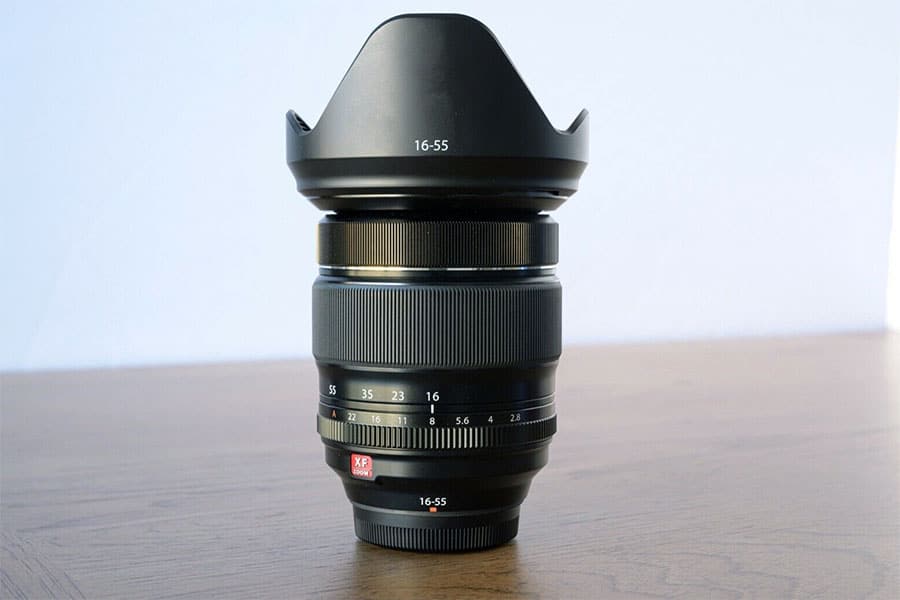
Sure, some photographers may lament the fact that the maximum aperture isn’t as fast as they’d like.
But if you’re shooting documentary or street photographs, most of the time you’ll want there to be some recognizable detail in the backgrounds of your images anyway; unlikely if shooting up close at, say, f/1.4.
Indeed, for street photography, f/5.6 or even f/8 will probably be your go-to settings .
Similarly, although center sharpness is very good, it’s got to be said that detail at the edges is much less well defined.
Yet for the kind of photographer this camera is aimed at, corner sharpness probably isn’t going to be a top priority.
Indeed, let’s just say that the X-Pro3 is not a camera that’s going to be especially appealing to landscape photographers anyway.
Color rendition is great, bokeh is very attractive, and the only other optical issue of note is a degree of (easily correctable) barrel distortion at wider focal settings.
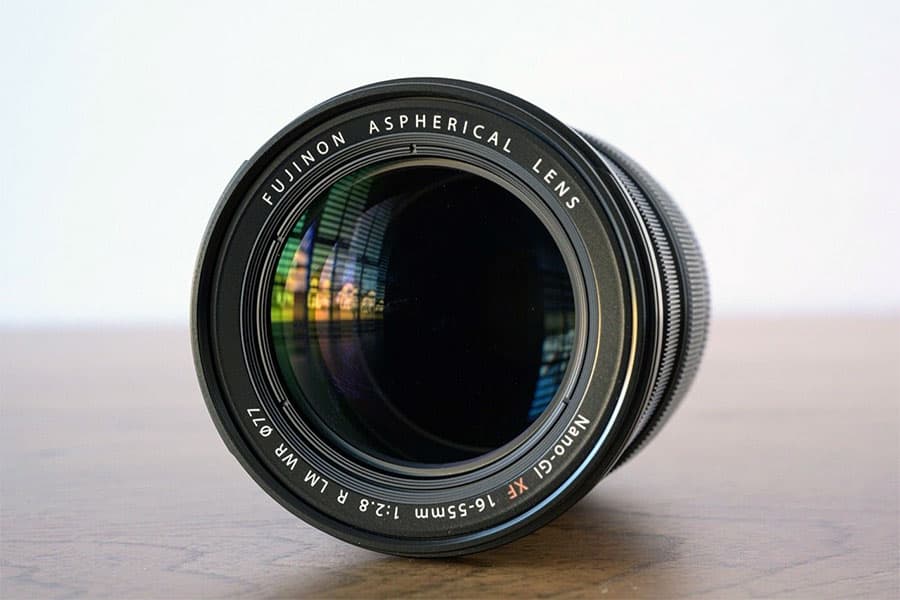
Autofocus is fast, accurate, and unobtrusive (i.e. near-silent).
And eye AF performs very well indeed; making it a tool you can rely upon for documentary and street work.
While manual focus is, predictably, of the “by wire” variety, it’s nonetheless reactive and satisfying to use.
The lens is well made, from premium materials; inspiring confidence that it’s up to the rigors of regular use out “in the field.”
The only real negative as an X-Pro3 user is that the 16-55mm f/2.8 lacks image stabilization.
Still, for the most part this will not be a major problem for the kind of photographs most X-Pro3 owners are interested in producing.
All in all, then, if you only purchase one lens for your X-Pro3, it should probably be this one.
Supremely sharp, and producing very pretty bokeh, the Fujifilm 23mm f/1.4 is a moderate wide angle prime lens that is particularly well suited to the X-Pro3’s way of working.
To be clear, it’s not the cheapest wide angle option for the X-Pro3 out there, but for documentary and street shooters who value both image quality and light gathering abilities, it’s likely the best.

The 23mm f/1.4 offers a field of view equivalent to a 35mm lens on full-frame, making it ideal for situations where you want to grab a relatively wide view of the scene, but without your subjects appearing like ants in the frame.
What’s more, the wide maximum aperture of f/1.4 will make this lens particularly appealing for both low light shooters and bokeh aficionados alike.
Generally speaking, image quality is excellent. Although the best results in terms of sharpness will be obtained by stopping down to about f/2.8 and beyond.
There’s almost no distortion, and flare is also very well controlled. However, you can expect to see a touch of vignetting at wider apertures.
Finally, beyond the purchase price, lack of both image stabilization and weather sealing are the only major turn-offs here.
Fast, sharp, and providing the dramatically wide POV favored by many a classic reportage photographer, the Fujifilm 16mm f/1.4 R WR is an excellent lens for use on the X-Pro3.
And while the 16mm f/1.4 might not stop a bullet for you, it’s nonetheless a solid and heavy chunk of glass that’s well suited to the rough and tumble of life on the street.
Offering a view equivalent to 24mm on full frame, the Fuji 16mm f/1.4 is probably about as wide as you can go on the X-Pro3 before encountering very serious framing problems with the optical viewfinder (be warned, though, that some may find framing a challenge even here).
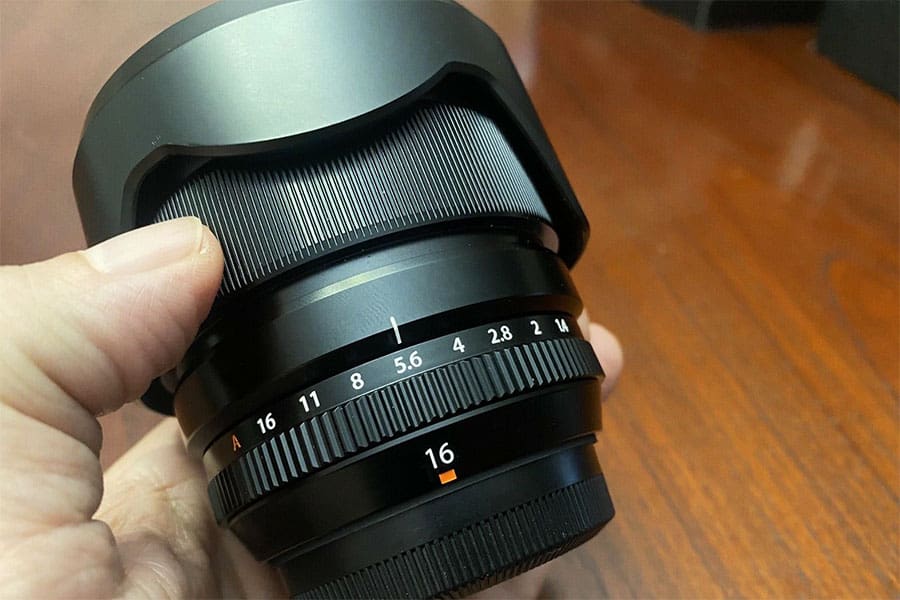
In any case, for regular day-to-day shooting, 24mm is also as wide as most people would want to go.
To be sure, unless you’re in the habit of standing so close to your subject that you can taste their shampoo, 24mm is already going to leave most of your scene extremely small in the frame.
Still, many documentary photographers love wide angle lenses for their ability to include an entire narrative in a single shot whilst simultaneously adding a good dose of dynamism to the composition.
If that’s you, rest assured that the the Fuji 16mm f/1.4 will not disappoint.
For a start, there’s that ultrafast aperture; meaning that you can keep on shooting in even the lowest of light.
Meanwhile, whether you favor AF action or manual control via the 16mm’s grippy ring, focusing is a real pleasure and results in beautifully sharp shots.
Talking of which, optical performance with the 16mm f/1.4 is consistently great, with no noticeable distortion, and flare and ghosting kept firmly under control.
True, you may notice a little softness at the corners when shooting at f/1.4.
But even this disappears after shutting the diaphragm down a stop or two.
Finally, as this lens is built from metal and sealed against the elements, you can be confident that it’s one that will be with you for many years to come.
Grab the Fujifilm 16mm f/1.4 R W for uncompromising documentary work in low lighting conditions.
Just be sure you’re psychologically prepared for the investment before adding this premium bit of glass to you shopping cart; it ain’t cheap!
Fuji excels at affordable, solid, high-performing primes. Of which the 23mm f/2 R WR is a great example.
And let’s face it, few photographers will want to be without a good, fast 35mm (equivalent) lens in their optical arsenal.
Of course, it’s not the fastest of Fuji’s 23mm primes. B
ut it will be plenty fast enough for most X-Pro3 users, and comes in at a much more attractive price than the f/1.4 alternative.
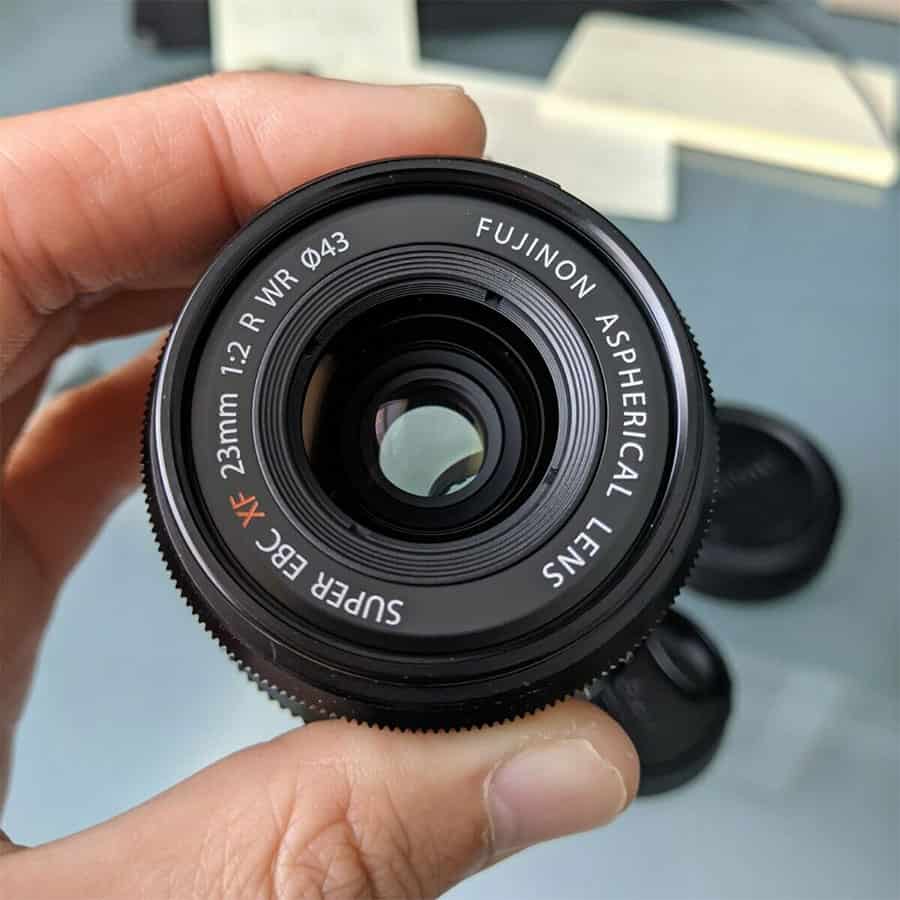
Despite an all-metal build, the Fujinon 23mm f/2 R WR is very lightweight and discrete; making it an ideal lens for street photography.
It features fast, silent autofocus that performs consistently well, with eye AF also delivering the goods. One word of caution though; although autofocus is fast and accurate, video shooters should be aware that there’s occasionally some pulsing before locking on to a subject.
As with many other Fujinon lenses, there’s both a physical aperture ring and a manual focus ring – albeit one that is controlled “by wire.”
The lens displays good resolution and contrast, even at its widest aperture setting.
And contrast only improves further as you stop down. By f/5.6 detail and sharpness are very impressive indeed.
On the downside, though, bokeh is only mediocre. To be clear, out-of-focus rendering is not at all bad, but I find that backgrounds can be a little busy on certain subjects.
All things considered, then, the Fujinon 23mm f/2 R WR is dependable little bit of glass that will not let you down for daily use.
And if you’re the kind of street or documentary photographer who generally prefers to achieve a moderately deep depth of field for greater background detail, it would makes little sense to spend the extra money on Fuji’s faster 23mm f/1.4.
Especially as the f/2 lens also comes with the added advantage of being weather sealed.
Another honestly-priced, high-performing, and robustly-built prime lens from Fuji, the 35mm f/2 R WR offers excellent image quality and snappy autofocus in a “standard” focal length (i.e. equivalent to 52mm on full frame).
Image quality is excellent overall. Used at f/2, images are super sharp and contrasty in the center, with resolution only dropping off at the extreme corners.
And by f/5.6 any edge softness has totally cleared up anyway.
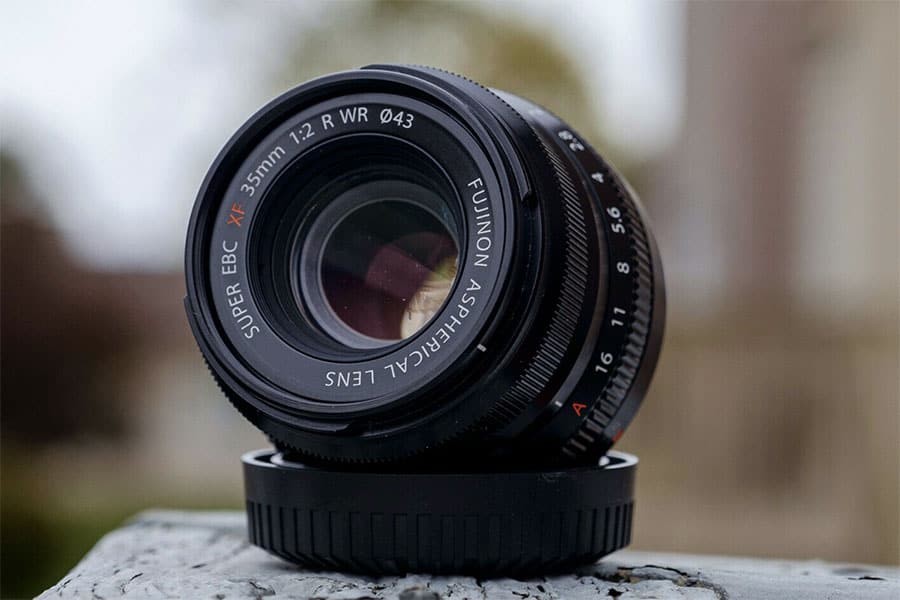
However, some barrel distortion is present when bypassing Fuji’s image correction software, and there is a slight degree of vignetting.
Flare, on the other hand, is exceedingly well controlled.
While bokeh is certainly smooth, it is largely unremarkable.
So don’t expect to see anything too exciting going on in the background (depending on your point of view, though, this might not be such a bad thing anyway).
Autofocus performs excellently. However, you’ll notice some pretty extreme focus breathing when moving focus between background and foreground elements; for stills this isn’t really a problem, but can be a major irritant for videographers.
The lens features a satisfying manual focus ring and an aperture ring that is adjustable in clicks of one third of a stop.
While cheaper than the 35mm f/1.4, the f/2 is admittedly not a particularly sexy bit of glass.
Nonetheless it is weather sealed, build quality is superb, and the small size is very convenient.
In short, what you get is solid performance from a lens that is more than capable of delivering high quality, gimmick-free photographs.
Who needs sexy?
Small, lightweight, and enviably fast, the Fujinon 35mm f/1.4 R makes an appealing alternative to the f/2 version (above).
Indeed, given its superior light-gathering abilities, and slight edge in terms of optical performance, plenty of X-Pro3 owners will likely be tempted to spend the extra couple of hundred dollars on this lens over the f/2.
Whether the increased investment is worth it for you will depend on your own particular photographic needs.
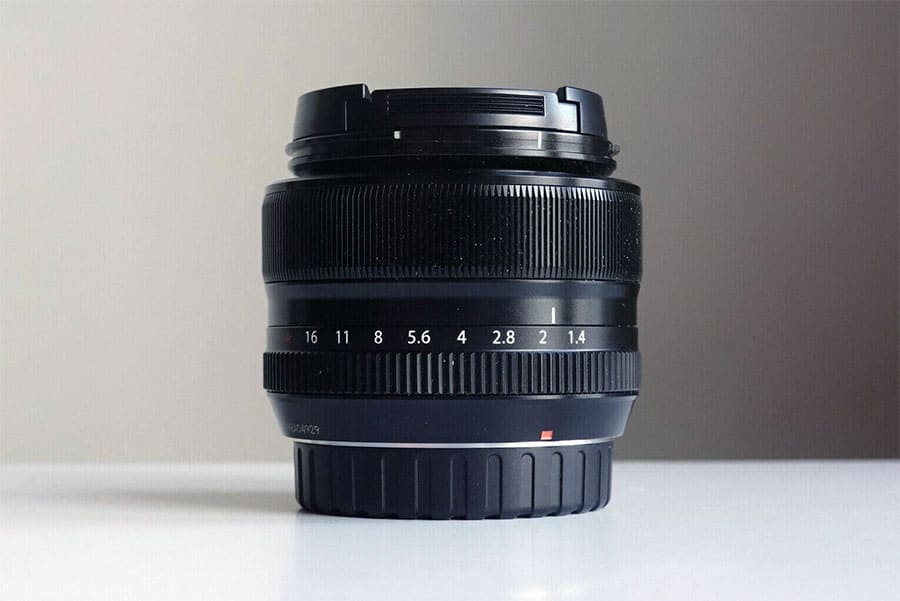
For a start we’re talking about over a stop more light hitting the sensor; easily enough to make the difference between a correctly- and under-exposed image. Likewise, when considered in terms of an advantage in shutter speed, a single stop could make all the difference when trying to handhold a shot in low light.
As mentioned above, there’s also some difference in terms of image quality; compared to the 35mm f/2, the f/1.4 has a very nice look and is a touch sharper.
Indeed, the f/1.4 is very sharp in the center, with the corners also falling into firmly line at apertures of f/2.8 and beyond.
Meanwhile color and contrast are very nice, and images look noticeably attractive right out of camera on the X pro 3.
AF is snappy and doesn’t hunt when used on average subjects.
Although it can be more sluggish when shooting against the light or in other tricky situations.
Also be aware that there is some motor noise, making this lens less than ideal for video.
Despite being the faster and more expensive of Fuji’s two 35mm lenses, the 35mm f/1.4 R is actually the older model and as a result comes without the weather sealing offered by the f/2.
Finally, take note that neither of the two 35mm lenses offer image stabilization.
Although the X-Pro3 is not specifically a “portrait camera” there’s certainly nothing about its design that would preclude owners from using it for this purpose.
In any case, while the Fujinon 56mm R f/1.2 offers an angle of view that is commonly considered ideal for portraiture (equivalent to an 84mm lens on full frame), in practice it’s a focal length that is also well adapted to numerous other shooting scenarios.
Indeed, from reportage and street-style to headshots and sports, this is a lens that many X-Pro3 shooters will enjoy having around.
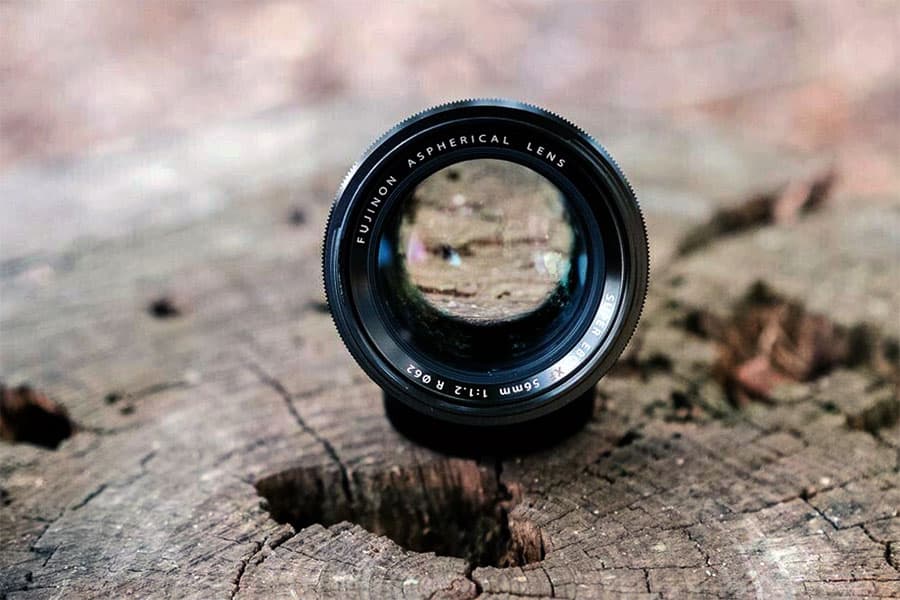
The main draw of the 56mm f/1.2 is simply image quality. Central sharpness is excellent, even when shooting at f/1.2.
What’s more, while there is a degree of fall-off in optical clarity towards the edges, this is really no more than is to be expected of a lens this fast.
Although an aperture of f/1.2 will produce a depth to field that is too shallow for most wide street scenes, it makes a lot of sense on a lens of a slightly longer focal length such as the 56mm f/1.2.
Now you can isolate a face in a crowd or pick out a subject at a distance, reducing the rest of the scene to a pleasing blur. Rather than all-encompassing Winograndesque street views, think McCurry-style portraits or diCorcia’s Heads series.
Aiding you in the task of freezing snippets of everyday public life is the 56mm f/1.2’s impressively zippy autofocus, which remains fast and accurate even in tricky lighting situations.
Sadly, though, the “by wire” manual focus action is less of a joy to work with.
And although the Fuji 56mm f/1.2 is sturdily built from strong materials, those who require either weather sealing or image stabilization will need to look elsewhere, as this lens provides neither.
X-pro3 Lens Buying Guide
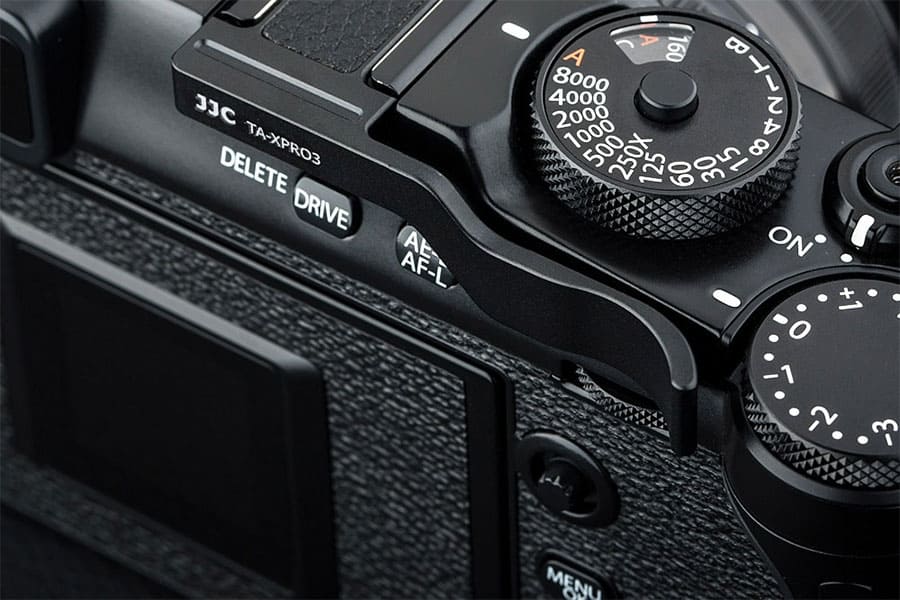
Focal Length
One of the most notable features of the X-Pro3 is its LCD screen; rather than facing outwards like a regular LCD, it instead faces inwards towards the back of the camera.
As a result, it must be flipped down before it can be used. This essentially makes the screen useless for shooting anything other than very low POV shots, thus forcing users to hold the camera at eye-level and shoot via the viewfinder most of the time.
In short, not only does the X-Pro3 look a lot like an old Leica, but it effectively coerces you into using it like one too. While some might consider this design an infuriating liberty on Fuji’s part, the fact is that many photographers absolutely love it.
Like it or loathe it, though, there are restrictions connected with the optical viewfinder that make it somewhat impractical with certain lenses; specifically ones with a very wide or very long focal length.
Simply stated, with an ultra wide angle or a telephoto on the front of the X-Pro3, framing is neither convenient nor accurate.
For practical reasons, then, I’ve largely included lenses in this review that range from moderately wide angle to moderately telephoto.
And if you are an X-Pro3 owner and concerned about framing issues, you would be well advised to keep your search for lenses within this range too.
With that said, it’s important to keep in mind that the vast majority of photos produced within the travel, documentary, and street photography genres – evidently the target markets for this camera – are made using lenses that easily meet these criteria. In short, if you are a typical X-Pro3 user, you probably weren’t considering buying a 70-300mm zoom anyway.
Maximum Aperture
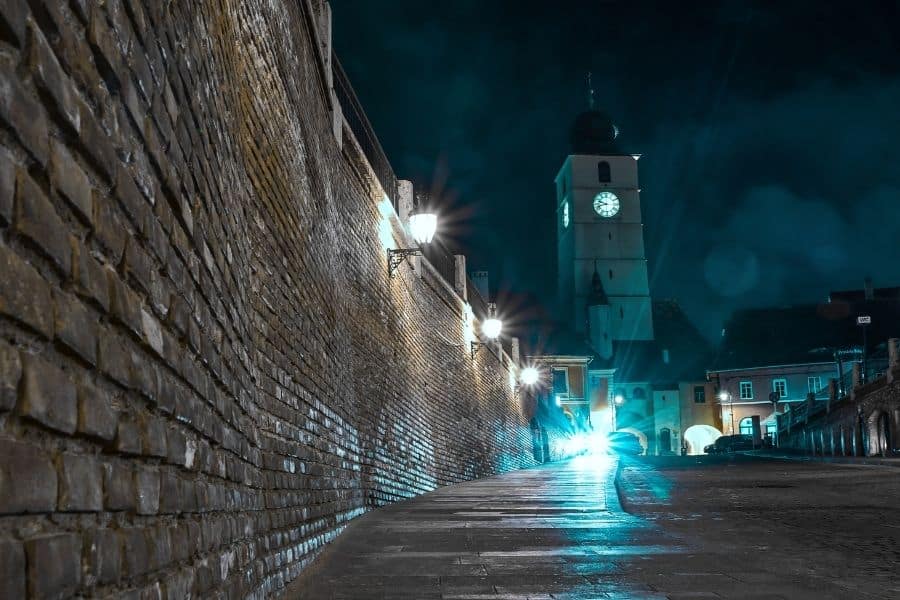
A wide maximum aperture will let in more light, permitting you to shoot at a lower ISO and/or a faster shutter speed. However, it will also throw the background more out of focus. This may or may not be an effect that you value in your photography.
Indeed, while blurred backgrounds are often very desirable in portraiture, it has to be said that documentary, travel, and street photographers tend to vary quite considerably in their approach here.
For example, some street photographers like to home in on their main subjects, isolating them from the urban environment à la Bruce Gilden; others strive for an effect that is closer to a painterly tableau, and therefore value much greater depth of field.
In practice, though, it’s likely that the majority of photographers will oscillate between these two extremes, depending on the desired effect and the available light.
There’s no right or wrong approach to street and documentary photography, so ultimately whether you choose to purchase a particularly fast lens or not is a matter of personal taste.
Taste, and budget; expect to pay a considerable premium for a lens that lets in even a single stop more light.
Bokeh

As all photographers who have spent any amount of time on the internet know, bokeh is a word used to describe the quality of out of focus areas of an image.
Although bokeh is undoubtedly somewhat subjective, good bokeh is generally considered to mean smooth out of focus rendering, while particularly busy or “bitty” backgrounds are a lot less desirable.
Of course, bokeh is alway more noticeable in a photo with a narrow depth of field.
So precisely how important lens bokeh is to you will in part depend on how you answered the question above regarding maximum aperture.
If you can see yourself shooting with the diaphragm wide open most of the time, using a moderately long lens, bokeh might well be something you should give careful consideration to when choosing a lens for your X-Pro3.
But if instead you’re more the kind of photographer who grabs a wide angle lens, sets aperture to f/8, and then leaves it there, bokeh will probably be of much less concern to you.
Sharpness
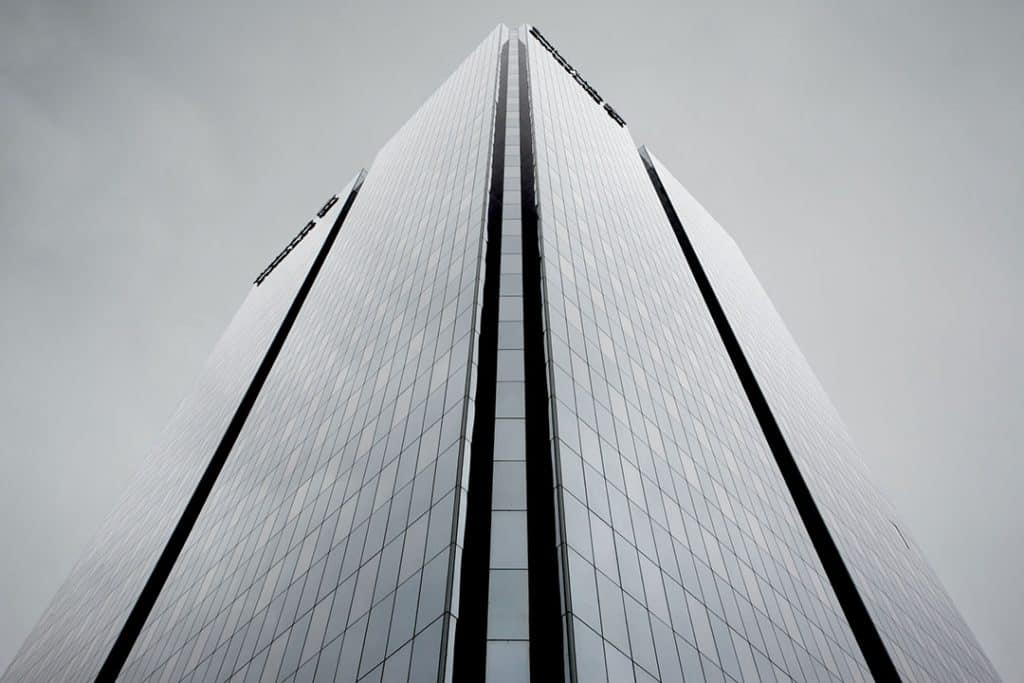
Let’s be totally clear; the average modern lens is exceedingly sharp over all.
If you find yourself with one to the contrary, it’s either a really cheap piece of junk or is a dud and should be returned to the manufacturer for replacement.
Having said this, where there does tend to be some variation in terms of lens sharpness – even among very expensive modern lenses – is towards the corners of the frame.
Corner softness will be most noticeable at wider apertures, and largely tends to clear up as you stop the lens down.
You can then expect to see a slight return of softness from about f/16 onwards. This is normal.
How much of a biggie corner softness is for you will largely depend on the genre of photography you do.
For landscape photographers – who generally seek out maximum sharpness and depth of field – it can be a real issue. But the X-Pro3 isn’t really a camera that will appeal to many dedicated landscape photographers anyway.
Instead, for the kinds of images most X-Pro3 users will want to produce – documentary work, street photography, and the occasional portrait – edge sharpness is much less critical.
True, if you’ll be using your X-Pro3 as your main travel photography camera, and plan on shooting any landscapes while on the road, you might do well to hunt out those Fuji lenses that perform best at the edges.
But for landscapes you’ll want to shoot at a fairly narrow aperture anyway, and by that point most Fuji lenses will be performing spectacularly.
In short, yes, sharpness matters, but it’s rare to find a modern lens that isn’t sharp enough for the job.
Zoom lenses vs Prime
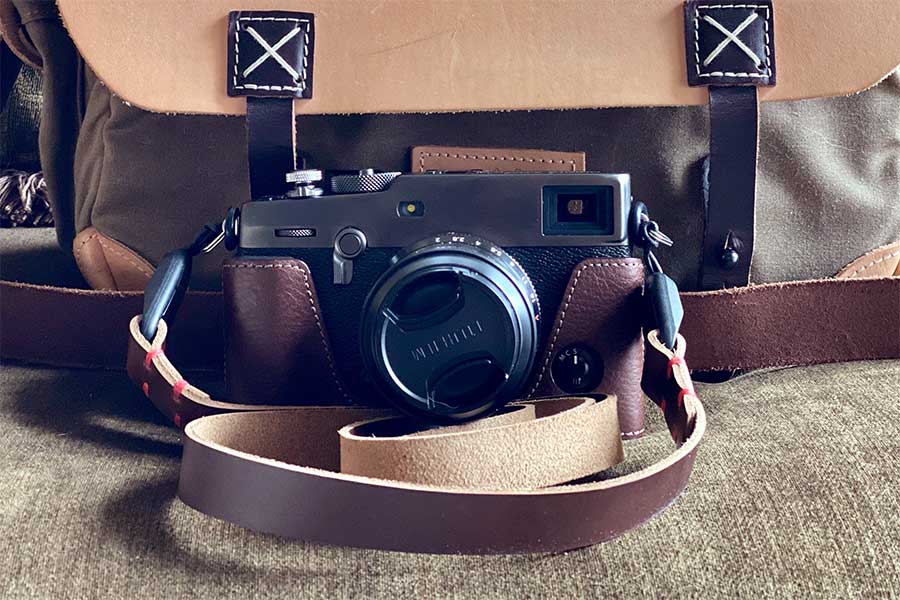
Some photographers can’t see the point of primes; after all, why carry around several heavy lenses when you can just buy a single zoom and be done with it.
Meanwhile, others despise zooms and won’t use anything but primes.
There’s no right or wrong approach, and both primes and zooms come with their respective advantages and disadvantages. A good zoom can certainly be very handy.
But if by “good” we mean optically sound and with a fast maximum aperture, you can expect to pay quite a lot for such a zoom lens.
Meanwhile, as primes are much simpler to manufacture, the cost of a sharp, fast prime will be way below that of a comparably specced zoom.
Of course, you’ll need to buy more than one prime if you’re going to be able to cover the same range of focal lengths offered by even the shortest zoom.
Food for thought.
Image Stabilization
Image stabilization is very handy, and can make the difference between a sharp and detailed shot of award-winning quality, and an amateurish blur.
Sadly, though, the Fuji X-Pro3 doesn’t come with IBIS (on-board optical image stabilization). And nor do the majority of Fujinon’s X-mount lenses feature OIS.
If you can find a Fujinon lens that meets your requirements and comes with OIS, great! For the most part, though, as an X-Pro3 user you’ll likely need to accept the fact that you will not be enjoying the benefits of image stabilization any time soon.
Useful Links
Final Thoughts
The X-Pro3 is a fantastic camera that is ideal for photographers who primarily want to shoot documentary, street, and travel photography.
But with its restricted LCD and analog-style viewfinder, it is better suited for use with some lenses than others.
In this guide I’ve considered which criteria to look out for when choosing the right lens for your own photography with the X-Pro3, and given a run down of what I believe to be the best lenses for the Fuji X-Pro3 currently on the market.
But what do you think? I’d love to hear about your own experiences of shooting with the X-Pro3. Let me know in the comments section below!

